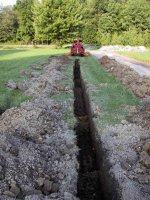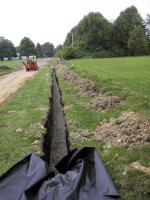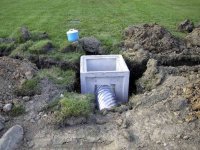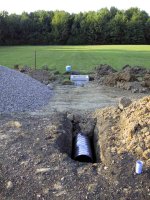I'll try and get a picture.
That would be very good - just for everyone reading here to obtain a good understanding of the layout of the structure and terrain .... nothing like putting a set (or sets) of eyes on it.
The basement is buried for the most part. It's under the deck so hard to say .....
The basement actually goes under the deck - the deck goes over top of it ?
If so, what type of roof is on the basement under the deck ?
and not sure how much water lies under there after a rain, I'll try to see.
Yeah .... this ya gotta know .... to really understand what might or might not be occurring.
One side of the house stays dry (it's 4 feet higher due to multi level layout and carpeted) the other takes on water in the far corner area.
IC.
rswyan - it's very simple - yes the land slopes down into my house where the leak is occurring.
Yup .... figured it might be .....

In other words as you walk AWAY from the wall of the house that leaks you're walking straight up a very steep grade, there's a mountain behind my house.
Right.
So it's very easy to picture water running down towards the house where it's leaking.
Yup ....... exaaactly ! :thumbsup:
The ground is basically flat about 10 feet behind the house where the deck is before the steep slope begins.
IC.
The point just before the slope begins is where you need to have the diversion ditch or channel.
I'm assuming a bit here - primarily that when there is precipitation, or at least heavy rain, that there is some surface runoff that coming down that slope.
There is undoubtedly ground, or subsurface, water percolating down the mountain as well.
The diversion ditch should be capable of collecting all the flow that comes down on the surface and then channeling it away from the foundation. It could be as simple as a small ditch a couple of inches deep and maybe foot wide (or even less) - whatever it takes to catch the surface flow. It could be planted in grass .... or covered with washed gravel (no fines) and/or rip-rap.
I would suggest placing or burying some heavy gauge plastic (10 mil poly or better) at the bottom for a barrier to prevent the water from seeping down into the soil. Make it wider than the ditch itself and tie it in by covering the edges with several inches of the existing soil. Then cover the center with either topsoil or gravel.
You might wish to make it long enough to completely divert the water away from the foundation and carry it off to where it is no longer a problem - or you might want to route the ditch (and the surface runoff) into a catch-basin (large or small, depending on your needs) and then use hard pipe to carry it to wherever it needs to go (the creek ?)
This ditch could be directly over any french drain system you install - but in no case should you allow the surface runoff to go into the french drain - handle it separately - you don't want more water going into the ground anywhere near, or upslope from, the foundation.
It's hard, terrible, mountain soil with not very thick grass, some exposed soil.
Lots of clay ?
There's also a drainage cover at the landing of the outside stairs to the basement door so there's obviously something down there at the footer level.
You hope ......
Never underestimate the ability of people to be completely stupid and do things which make absolutely no sense whatsoever, and which border on being criminal.
Stuff like placing a drain cover ......
which goes nowhere ..... (not connected to piping) .... not saying that's what you have, but it ain't outta the realm of possibility ....
The fact that the slightly higher side of the house doesn't take on water makes me wonder if it's a ground water/footer issue and a french drain isn't going to help?
Ground water is
exactly what a french drain is designed to
solve
My upper front yard is a field about an acre plus which is separate from the lower front by my driveway. The grade of the land is from the upper yard to the lower one. The driveway is roughly 12" - 18" above lowest part of the upper yard - thereby forming a barrier to surface runoff.
When it rained water would pool at the lowest points of the upper yard and it would stay wet for days .... and days ........ and days .... couldn't get into mow it without making a terrible mess and rutting it all up.
I dug roughly 250' of trench, 3' or so deep and installed a french drain using washed 57 gravel (about 18" deep) and 4" perforated pipe (with soil sock) placed near the bottom of the trench .... and then routed that to a catch basin which had a culvert that went under the driveway and emptied out in the lower yard. The trench was then covered with topsoil and planted in grass.
The result is that the upper yard no longer holds water - within 24 hours after a heavy rain there is no standing water, and within a couple of days (of dry weather) I can take the tractor on it.
On the french drain you are going to need to go deep enough to catch the majority of the subsurface water coming down the mountain ..... I would think that ideally it would be below the grade of your foundation.
It should be placed out away from the foundation some distance (out past the deck sounds like the place to me) -
so that it both intercepts the flow of subsurface water coming down the mountain .... and draws water away from the foundation.
It should be capped well below the surface with an imperious material (say, clay) that will prevent surface runoff from finding it's way down there.
You might want to have a look at the following article, as well as the other articles on that site:
The French Drain: Theory, Application & Practice


